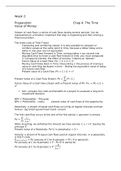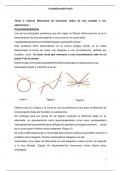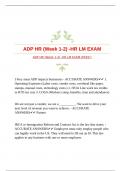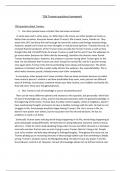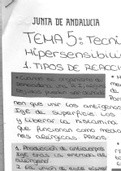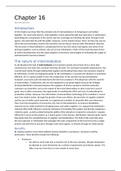Week 2:
Preparation: Chap 4: The Time
Value of Money
Stream of cash flows: a series of cash flows lasting several periods. Can be
represented on a timeline: important first step in organizing and then solving a
financial problem.
The three rules of Time Travel:
- Comparing and combining values: It is only possible to compare or
combine values at the same point in time, because a dollar today and a
dollar in one year are not equivalent.
- Moving Cash Flows Forward in Time: compounding = our second rule
stipulates that to move a cash flow forward in time, you must compound
it. Compound interest: the effect of earning “interest on interest”.
Future Value of a Cash Flow: FVn = C x (1 + r)n
- Moving Cash Flows Back in Time: Discounting = the process of moving a
value or cash flow backward in time – finding the equivalent value of today
of a future cash flow.
Present value of a Cash Flow: PV = C / (1 + r) n
N
Present Value of a Cash Flow Stream: PV = ∑ PV (C n )
n=0
Future Value of a Cash Flow stream with a Present Value of PV: FV n = PV x (1 +
r)n
Aim: compare the costs and benefits of a project to evaluate a long-term
investment decision.
NPV = PV(benefits) – PV(costs)
NPV = PV(benefits – costs) present value of cash flows of the opportunity
Perpetuity: a stream of equal cash flows occurring at regular intervals and last
forever. (eg british government bond: consol).
The first cash flow occurs at the end of the first period = payment in arrears.
∞
C
PV = ∑( n
n =1 1+r )
When investing, we withdraw the interest we have earned, C = r x P, leaving the
principal P.
Present Value of a Perpetuity: PV (C in perpetuity) = C/ r
Annuity: a stream of N equal cash flows paid at regular intervals. ≠ w perpetuity
is that it ends.
Pinitial investment = PV (annuity of C for N periods) + PV ( P in period N)
PV (annuity of C for N periods) = P – PV (P in period N)
−P
PV (annuity of C for N periods) = P
( 1+ r )N
, Present Value of an Annuity: PV (annuity of C for N periods with the interest rate
−1
r) = C x (1/ r) (1 ¿
( 1+ r )N
Future Value of Annuity: FV (annuity) = C x (1/r) ((1 + r)N – 1)
Growing Perpetuity: a stream of cash flows occurring at regular intervals and
grow at a constant rate forever. The first payment doesn’t include growth.
∞
C ( 1+ g )n−1
PV = ∑ n
n =1 ( 1+r )
Present Value of a Growing Perpetuity: PV(growing perpetuity) = C / (r – g)
Growing annuity: a stream of N growing cash flows, paid at regular intervals. It is
a growing perpetuity that eventually comes to an end. The fist cash flow still
arrives at the end of the first period and the first cash flow does not grow.
1 1+ g N
Present Value of a Growing Annuity: PV = C¿ (1− )
r−g 1+r
PMT present value of annuity + FVpresent value of final payment + PV initial amount =0
Everything about annual cash flow streams applies to monthly cash flows
streams as long as the interest rate is specified as a monthly rate, the number of
periods is expressed in months.
Loan payment problem: to solve it, refer the load principal as the present value.
Then just has to inverse the annuity formula.
P
Loan or Annuity Payment: C = ∗(1− 1 )
1
r ( 1+ r )N
Internal rate of return (IRR) = the interest rate setting the net present value of
cash flow to 0
IRR with 2 cash flows = (FV / P)1/N – 1 compound annual growth rate
(CAGR)
IRR of growing perpetuity = (C/P) + g
Chap 5: Interest rates
Interest rates are often stated as effective annual rate (EAR): indicates the actual
amount being earned at the end of one year.
Adjusting the Discount Rate to Different Time periods: changing the power of the
interest rate (1 + r)
General Equation for Discount Rate Period Conversion: Equivalent n-Period
Discount Rate = (1+r)n –1
Annual Percentage Rate (APR) indicates the amount of simple interest earned in
one year, without the effect of compounding.
A way of quoting a monthly interest rate, rather than an annual one.
Preparation: Chap 4: The Time
Value of Money
Stream of cash flows: a series of cash flows lasting several periods. Can be
represented on a timeline: important first step in organizing and then solving a
financial problem.
The three rules of Time Travel:
- Comparing and combining values: It is only possible to compare or
combine values at the same point in time, because a dollar today and a
dollar in one year are not equivalent.
- Moving Cash Flows Forward in Time: compounding = our second rule
stipulates that to move a cash flow forward in time, you must compound
it. Compound interest: the effect of earning “interest on interest”.
Future Value of a Cash Flow: FVn = C x (1 + r)n
- Moving Cash Flows Back in Time: Discounting = the process of moving a
value or cash flow backward in time – finding the equivalent value of today
of a future cash flow.
Present value of a Cash Flow: PV = C / (1 + r) n
N
Present Value of a Cash Flow Stream: PV = ∑ PV (C n )
n=0
Future Value of a Cash Flow stream with a Present Value of PV: FV n = PV x (1 +
r)n
Aim: compare the costs and benefits of a project to evaluate a long-term
investment decision.
NPV = PV(benefits) – PV(costs)
NPV = PV(benefits – costs) present value of cash flows of the opportunity
Perpetuity: a stream of equal cash flows occurring at regular intervals and last
forever. (eg british government bond: consol).
The first cash flow occurs at the end of the first period = payment in arrears.
∞
C
PV = ∑( n
n =1 1+r )
When investing, we withdraw the interest we have earned, C = r x P, leaving the
principal P.
Present Value of a Perpetuity: PV (C in perpetuity) = C/ r
Annuity: a stream of N equal cash flows paid at regular intervals. ≠ w perpetuity
is that it ends.
Pinitial investment = PV (annuity of C for N periods) + PV ( P in period N)
PV (annuity of C for N periods) = P – PV (P in period N)
−P
PV (annuity of C for N periods) = P
( 1+ r )N
, Present Value of an Annuity: PV (annuity of C for N periods with the interest rate
−1
r) = C x (1/ r) (1 ¿
( 1+ r )N
Future Value of Annuity: FV (annuity) = C x (1/r) ((1 + r)N – 1)
Growing Perpetuity: a stream of cash flows occurring at regular intervals and
grow at a constant rate forever. The first payment doesn’t include growth.
∞
C ( 1+ g )n−1
PV = ∑ n
n =1 ( 1+r )
Present Value of a Growing Perpetuity: PV(growing perpetuity) = C / (r – g)
Growing annuity: a stream of N growing cash flows, paid at regular intervals. It is
a growing perpetuity that eventually comes to an end. The fist cash flow still
arrives at the end of the first period and the first cash flow does not grow.
1 1+ g N
Present Value of a Growing Annuity: PV = C¿ (1− )
r−g 1+r
PMT present value of annuity + FVpresent value of final payment + PV initial amount =0
Everything about annual cash flow streams applies to monthly cash flows
streams as long as the interest rate is specified as a monthly rate, the number of
periods is expressed in months.
Loan payment problem: to solve it, refer the load principal as the present value.
Then just has to inverse the annuity formula.
P
Loan or Annuity Payment: C = ∗(1− 1 )
1
r ( 1+ r )N
Internal rate of return (IRR) = the interest rate setting the net present value of
cash flow to 0
IRR with 2 cash flows = (FV / P)1/N – 1 compound annual growth rate
(CAGR)
IRR of growing perpetuity = (C/P) + g
Chap 5: Interest rates
Interest rates are often stated as effective annual rate (EAR): indicates the actual
amount being earned at the end of one year.
Adjusting the Discount Rate to Different Time periods: changing the power of the
interest rate (1 + r)
General Equation for Discount Rate Period Conversion: Equivalent n-Period
Discount Rate = (1+r)n –1
Annual Percentage Rate (APR) indicates the amount of simple interest earned in
one year, without the effect of compounding.
A way of quoting a monthly interest rate, rather than an annual one.


